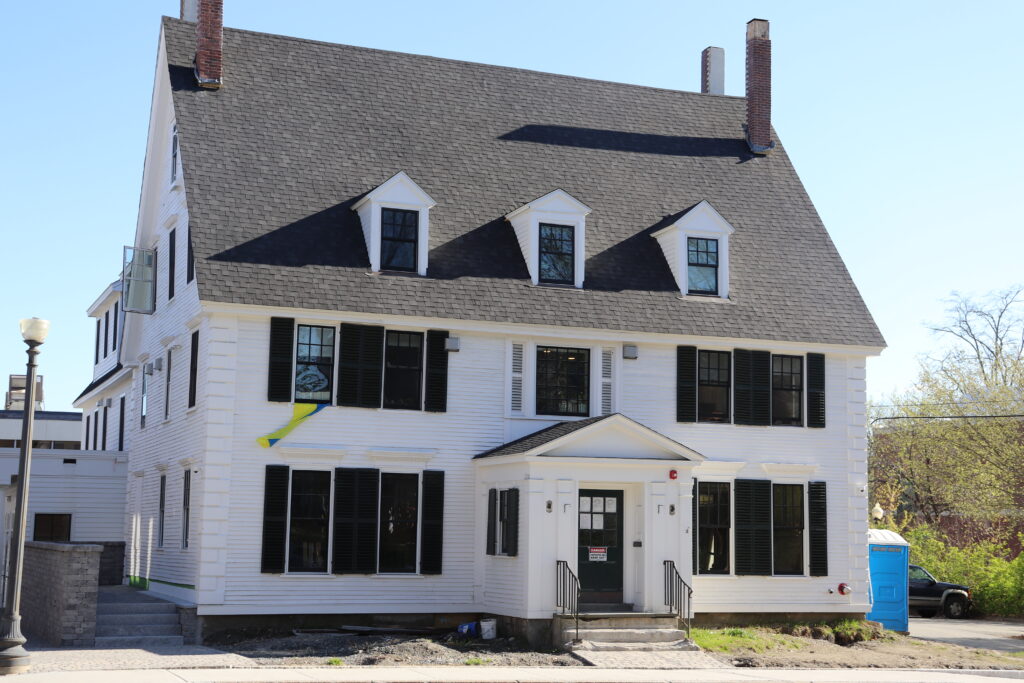
Situated on West Wheelock Street, directly across from the Collis Center, the Wheelock House is the oldest standing building in Hanover. As the name would suggest, this stately white mansion was built for the College’s founder Eleazar Wheelock in 1773. Despite its size, the Wheelock House is not as grand as the presidential mansions on other college campuses, or even the mansion currently occupied by President Hanlon. In 1808, one medical student, William Tully, aptly described the mansion as “neat, but not elegant.”
Nevertheless, the Wheelock House was the first building in Hanover to be constructed with any sensibility of or focus on architectural style. It was certainly a substantial improvement upon the cabin in which Wheelock had originally resided, which he described as “a hut of logs.” Upon the completion of the mansion, this cabin was converted into servant quarters for the slaves who worked in Wheelock’s home. It was Wheelock’s wish to preserve this cabin as a historical landmark, but the cabin lasted only a dozen years after his death in 1779.
The Wheelock House was originally constructed just off the Southeastern corner of the Green, where Reed Hall stands today. It was used as a presidential mansion through 1830, serving as a home to Presidents John Wheelock ’71, William Allen, Bennett Tyler, and Nathan Lord. When the College wished to expand its academic buildings in 1838, it purchased the Wheelock House and then sold it with the caveat that the new owner would remove the house from its existing location. Thus, as Reed Hall was constructed in the southeast corner of campus, the Wheelock House was dragged, fully intact, several hundred yards to its current spot on West Wheelock Street.
Hanover philanthropist Emily Howe lived in the house for the lion’s share of the second half of the 19th century. In 1899, she donated the house to the town of Hanover as a library at the urging of her good friend Hiram Hitchcock. Emily hired a College architect to remodel the house from top to bottom. The external remodel incorporated styles from both Colonial and Victorian architecture, copying various elements that were common across New England at the time. On the interior, the main floor, which had become a duplex, was integrated once again to allow for the more effective distribution of books. Following Emily’s death in 1912, the library was the beneficiary of her remaining fortune, which was devoted towards the addition of a two-story brick annex to the back of the building.
Eventually, the town of Hanover moved the library from the Wheelock House to another location on East South Street, and the house was sold for commercial use. It was subjected to various commercial endeavors, including most recently a florist’s shop, but the house was finally purchased by the Eleazar Wheelock Society in 2015.
The Eleazar Wheelock Society, or EWS, is composed largely of Dartmouth alumni, and it aims to “create environments among students, faculty, and alumni that elevate reason, promote development of robust ethical value systems, stimulate constructive discussion among faiths, and share Christian perspectives” at the College. Following its acquisition of the Wheelock House, the EWS funded a substantial renovation to make it a functional gathering space for students.
Recently, the Wheelock House has undergone a second wave of renovation funded by alumni in the Eleazar Wheelock Society, which has been rebranded as simply the Wheelock Society. With the addition of a significant annex, the house now serves as a shockingly glamorous residence for 24 lucky undergraduate students, mostly drawn from various Christian communities around campus.
The historic front rooms of the house originally used by Eleazar Wheelock himself are still under construction, but they are expected to be open for community events sometime in the 2023-2024 academic year.
Despite the recent closure of its principal common spaces in the Wheelock House in favor of residential rooms, the Wheelock Society itself has new vitality and a significantly increased presence on campus following the appointment of an on-campus director for the society, Charlie Clark ’11. The Wheelock Society now functions as an umbrella organization for many other Chrisitan-aligned groups on campus, including the Apologia, Dartmouth’s biannual journal of Christian thought. The Wheelock society now runs multiple termly reading groups on religious or religious-adjacent topics which are open to undergraduates, graduate students, and alumni.
Though the Wheelock Society is not a student ministry, in the aftermath of the pandemic it has become one of the perhaps two Christian groups on campus (alongside Aquinas House, Dartmouth’s Catholic Student Center) that could reasonably be considered robust and well attended. As such, it should be a first stop for any Christian or Christian-sympathetic students in search of sober reflection to break up the monotonous debauchery of campus life.

Be the first to comment on "Wheelock House and Society Update"